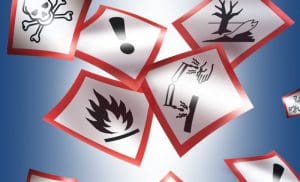By Nabila Al Hasan, Regulatory Compliance Specialist
 Globally Harmonized System (GHS) is an international effort to harmonize hazard communication. It provides harmonized hazard definitions, format for safety data sheets (SDS), and specific criteria for product labels. It issues a revised edition every 2 years and is currently working on releasing Revision 9 in 2021.
Globally Harmonized System (GHS) is an international effort to harmonize hazard communication. It provides harmonized hazard definitions, format for safety data sheets (SDS), and specific criteria for product labels. It issues a revised edition every 2 years and is currently working on releasing Revision 9 in 2021.
OSHA updated Hazard Communication Standard in 2012 to align with GHS Revision 3 which brought changes to hazard classifications, labels, safety data sheets, and providing information and training to employees. HCS 2012 required chemical manufacturers and importers to disclose identities and hazards of chemicals they produce or import. It also requires workplaces with hazardous chemicals to have a hazard communication program to protect the workers.
OSHA has recently proposed to update HCS to align with GHS Revision 7 in efforts to address issues identified while implementing HCS 2012 and to improve alignment with other U.S. agencies. It is unclear when this update will go into effect, but Global Safety Management (GSM) keeps a close eye on these developments and will update both its clients and TotalSDS, our patent-pending SDS authoring and management software, as soon as the date of compliance is issued by OSHA. TotalSDS makes generating compliant SDSs and revisions that result from regulatory updates seamless tasks for its subscribers.
Following updates are a few major changes that adopting GHS Revision 7 would bring:
- “Pyrophoric gases” and “Unstable gases” have been grouped under hazard class “Flammable Gases Category 1 A”
- The same updated hazard class now has a new subcategory of Category 1B for flammable liquids with a low burning velocity or high flammability limit. This change also leads to updated labeling information such as Hazard statement, Signal word, and Pictogram.
- There will be a new chapter in Appendix B (physical hazards) known as B.17 for “Desensitized Explosives”. This chapter will detail criteria for different categories, associated hazard statements, signal words, pictograms, and ways to suppress or reduce explosive properties of products containing these chemicals before being shipped or stored.
- This Revision will provide better differentiation between Aerosols and Gases Under Pressure. Aerosols with flammable components will be classified in Categories 1 or 2 and aerosols with no flammable components will be classified as Category 3. This update takes away the gas cylinder pictogram and adds revised hazard statements.
Stay tuned for further updates. GSM is committed to helping you simplify regulatory compliance. Please contact GSM to find out how we can help.


